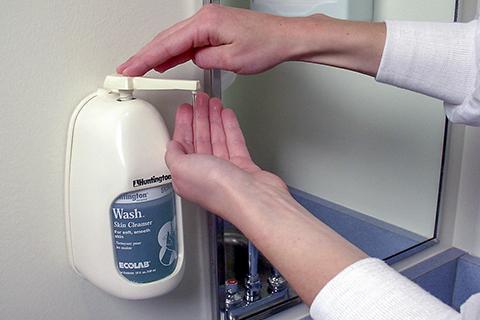
Excessive handwashing or washing with abrasive soaps are common ways to develop contact dermatitis.
You probably don’t give much thought to hand health. Until something goes wrong, almost everyone takes for granted that these crucial appendages will continue working as they always have. But hand health is an important consideration, especially at work.
According to the Centers for Disease Control and Prevention (CDC), allergic contact dermatitis and irritant contact dermatitis account for 15–20 percent of all reported occupational diseases, and they cost employers an estimated $1 billion each year in lost workdays and decreased productivity.
Based on guidelines from the World Health Organization, here’s what you need to know to stay healthy and productive.
What is Contact Dermatitis?
Contact dermatitis is a hand rash characterized by redness, swelling, and itching that comes in two forms—allergic and irritant.
Allergic contact dermatitis occurs when skin is exposed to a substance that elicits a short-term autoimmune response, leading to a delayed skin reaction typically 12–72 hours after exposure. Skin can become allergic to a substance after many exposures or after just one exposure. Symptoms of allergic contact dermatitis include reddening of skin; intermittently dry, scaly patches of skin; oozing blisters; burning or itching; swelling in the eyes, face and genital areas, in severe cases; hives; sun sensitivity; and darkened, leathery, and cracked skin.
Irritant contact dermatitis occurs when skin is repeatedly exposed to a mild irritant over time or is exposed to a strong irritant. Irritants can range from soaps to chemicals to cold air. Symptoms of irritant contact dermatitis include mild swelling; a stiff, tight feeling; dry, cracking skin; blisters; and painful ulcers. This type of dermatitis is common among people who regularly work with strong chemicals, detergents, or cleaning products or who wash their hands frequently.
Excessive handwashing also compounds skin damage by depleting the surface lipid barrier of the skin, which causes deeper penetration of detergents into the skin layers. This issue can be exacerbated by a lack of humidity in the atmosphere, a predisposition to dry skin, using hot water for handwashing, failure to use hand lotion or cream, low-quality paper towels, and the shear forces associated with wearing or removing gloves.
Healing contact dermatitis can be a long process because the damaged skin is especially sensitive to further damage. The American Academy of Dermatology recommends seeing a dermatologist, avoiding the irritant or triggering substance, and using barrier creams to facilitate healing and prevent re-injury.
Harsh Ingredients in Industrial Hand Cleansers
Workers who use industrial hand cleansers may be at an increased risk for contact dermatitis because many contain strong ingredients.
Petroleum distillates, for instance, are used as a solvent in some industrial cleansers to facilitate the removal of difficult materials such as heavy oil and grease. Petroleum distillates are derived from crude oil and are powerful compounds—some other forms include kerosene and various paint thinners.
Long-term exposure to petroleum distillates puts one at risk of dermatitis, but exposure in the short-term can still lead to skin inflammation, as the chemicals affect the fat layers around the skin surface, causing dehydration and inflammation. Furthermore, petroleum distillates are sometimes contaminated with carcinogenic chemicals that are absorbed through the skin—a fact scientists have recognized since the 1980s.
Along with petroleum distillates, the additives that some industrial cleansers use to remove grime can cause inflammation. Sand and pumice are commonly used for this purpose, but both are overly rough on the hands and can cause invisible abrasions in the skin. There are gentler alternatives such as corn meal, ground olive pits, and walnut shell that won’t cause irritation. These alternatives also have a smaller environmental impact because, unlike sand and pumice, they do not settle in ducts and pipes when washed away.
Taking Care of Your Hands
Paying attention to hand-washing products is important. Some people may be able to tolerate petroleum distillates, sand, and pumice in an industrial cleanser without any issues. But if your hands feel irritated and inflamed, your industrial cleanser may be at fault. In this situation, switching to a cleanser that is low-solvent or solvent-free or one that has gentler scrubbers could potentially rectify the issue.
Even if you are not using industrial cleansers, be aware of the irritation associated with frequent handwashing, because those using industrial cleansers are not the only ones at risk for dermatitis. Make sure to use lotions and creams frequently to minimize any effects of frequent handwashing.
Finally, this self-assessment tool can also help you gauge where you fall on hand health.

